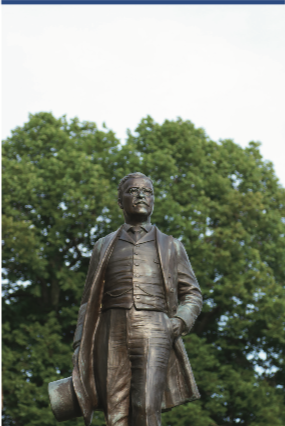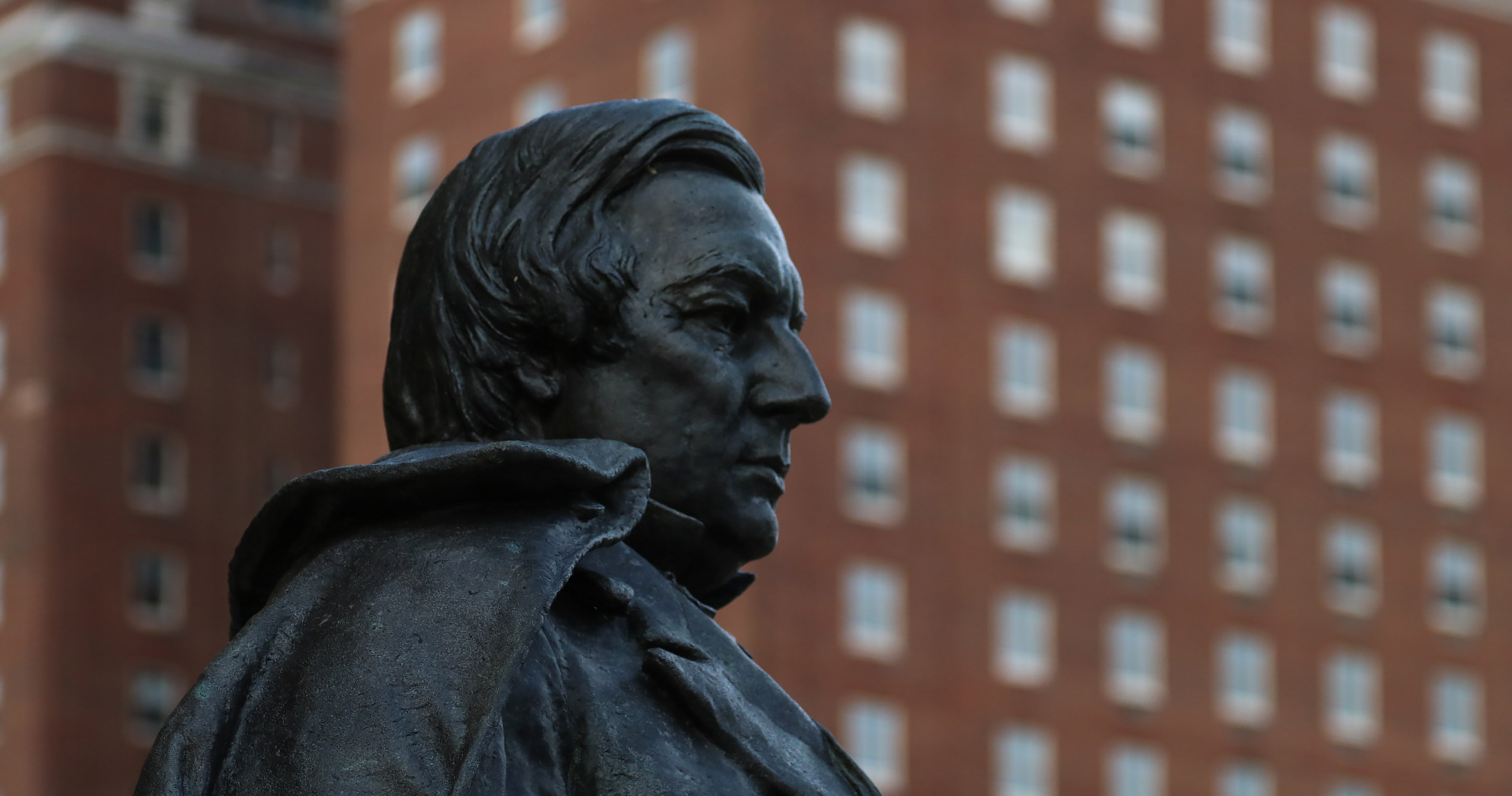Author: Caitlin Hartney
Photography: Kevin Heffernan
On October 2, 1851, Frederick Douglass’s abolitionist newspaper ran a scathing denunciation of then-sitting president, Millard Fillmore. The lede was prophetic:
“A curious task will be his who, in future time, attempts to write the history of the present administration. How shall it be known in history?”
It was a question to which the article put forth a caustic answer:
“Why as he goes home to Buffalo, mothers will bring their little children to see him, as he passes by, saying, ‘There he goes, the n*****-catching president.’”
Its author did not mince words, employing crude language in acerbic criticism of Fillmore’s support for and execution of the Fugitive Slave Act of 1850—a nefarious law that compelled Americans to aid in the capture of runaway slaves. In effect, Fillmore remanded hundreds of freedom-seeking black men, women, and children to the South, where hideous fates surely befell them.
Of course, that isn’t how we, residents of present-day Buffalo, remember Fillmore. Somewhere along the way, he traded the well-deserved mantle of slave catcher for that of illustrious local son.
Today, Fillmore’s name graces Western New York buildings and street signs, his bronze likeness stands sentinel before Buffalo City Hall, and each year on his birthday, leaders and officials gather in ceremony at his gravesite in Forest Lawn Cemetery. They are gestures of respect for the roles he had in establishing and advancing University at Buffalo, the Buffalo History Museum, the Buffalo Club, and other of the area’s important institutions. Meanwhile, his sins have been, by and large, ignored, in effect whitewashing the painful story of our incomplete progress toward a just and equal society.
Just as Confederate monuments have been catalyzing overdue conversations about our country’s deeply marred past, so, too, may Buffalo’s memorials serve as starting points of reckoning. Racism has never been proprietary to the South; Fillmore’s legacy ought to own up to that.

The same can be said for Theodore Roosevelt’s. It is easy to forget that Buffalo’s favorite adopted son was an ardent spokesperson for the virulent white supremacist masculinity that pervaded fin de siècle American culture. His was a particular brand of gendered racism that he promulgated in defense of Native American genocide and in advocation of his imperialist ambitions in the Philippines. In Roosevelt’s view, tribal societies were inherently lesser than, and their extermination or cultural conquest was necessary for the advancement of white civilization.
A prolific writer and talented orator, Roosevelt made no secret of his views. In Winning of the West, his four-volume history of the American frontier, Roosevelt traces the origin of a distinct, explicitly white, “American race” that proved its exceptionalism through the bloody conquest of “inferior” races. In vanquishing native people, he claimed, white Americans evolved toward a more perfect level of civilization.
“Whether the whites won the land by treaty, by armed conquest, or…by a mixture of both, mattered comparatively little so long as the land was won,” he wrote. “All men of sane and wholesome thought must dismiss with impatient contempt the plea that these continents should be reserved for the use of scattered savage tribes, whose life was but a few degrees less meaningless, squalid, and ferocious than that of the wild beasts with whom they held joint ownership.”
Roosevelt applied his principles to the imperial conquest of the Philippines. With the West won, he reasoned, Americans needed a new theater to perform the manly, violent feats he considered necessary for racial progress. The estimated 250,000 Filipino civilians that died of slaughter, malnutrition, and disease as a result of American intervention was, in Roosevelt’s view, an acceptable cost of the cause.
Of course, Roosevelt did not forge his belief system in a vacuum; he was representative of his era, gender, race, and class. As such, his properly dissected, fully contextualized legacy might serve as a starting point for understanding a time period that incubated our flawed modern culture.
At the end of the nineteenth century, Americans began to link manhood and racial power in novel, disturbing ways. Historians sometimes identify it as an era of white masculinity in crisis, thanks to a conflation of numerous factors that rendered the Victorian index of respectable manhood less attainable than ever before. In the face of narrowing career opportunities, the growing clout of the immigrant and working-class electorates, economic depression, and women’s growing political activism, middle-class white men began to identify with a new, aggressive brand of masculinity constructed in novel racial terms.
Roosevelt’s particular brand of imperialism was one manifestation of this phenomenon. A renewed fervor in the oppression of African Americans was another. In this cultural atmosphere, Jim Crow laws took shape, the Ku Klux Klan reemerged after years of dormancy, and racial terrorism, epitomized by the sadistic, ritualized lynching of black Americans, became normalized features of American life.
It was also in this context that turn-of-the-twentieth-century white supremacists raised many of the Confederate monuments that have become sites of impassioned controversy in recent years. The statues were at least as much about enforcing an insidious power dynamic as they were about honoring fallen soldiers.
Roosevelt’s belief system was a product of the same American moment as those Confederate statues and should not be judged less harshly. His metal-cast likeness along Buffalo’s Delaware Avenue is thus as entwined with systemic racial hierarchy as a tribute to Stonewall Jackson or Robert E. Lee. Rather than strike that reality from the historical record and our collective memory, we should come to terms with it as a first step toward reparation.
To the credit of those involved, some changes are already in motion. This past January, for the first time that anyone can remember, the annual commemoration at Fillmore’s gravesite addressed the thirteenth president’s grave moral errors. At the event, University at Buffalo Associate Professor Carole Emberton was given platform to speak of the toll on black Americans. Just days before the ceremony, she expounded on the same in a Washington Post article, where she suggested that the people and institutions of Buffalo not shy away from uncomfortable realities.
“Perhaps this year, as they gather in the cold at the hilltop gravesite in Forest Lawn Cemetery,” she wrote, “they at least will spare a moment of silence for…the…fugitive slaves who once sought refuge in their city, and for the citizens who challenged the very decree Fillmore signed.”
I say, Buffalo, it’s high time we do more than the very least.
Perhaps we can look to our neighbors in Niagara Falls for inspiration. There, a newly opened experiential museum stands in homage to the courageous freedom seekers who sought self-emancipation in Canada via the Cataract City. The Underground Railroad Heritage Center, as it is called, aligns philosophically with the International Coalition of Sites of Conscience, which believes that connecting the past to modern social justice issues can catalyze just resistance.
According to the coalition’s website, “Even with the best of intentions, erasing the past can prevent new generations from learning critical lessons and destroy opportunities to build a peaceful future.
If 2018 is any indication, history has a way of repeating itself. Collective awareness—and readiness for action—may be more important than ever.







